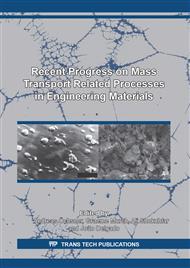[1]
R.S. Bubnova, S.K. Filatov, High-temperature crystal chemistry of borates and borosilicates, Science, Saint Petersburg, (2008).
Google Scholar
[2]
A.A. Osipov, L.M. Osipova, V.M. Bykov, Spectroscopy and structure of alkaline borate glasses and melts, Ural Branch of the Russian Academy of Sciences, Ekaterinburg – Miass, (2009).
Google Scholar
[3]
V.M. Denisov, N.V. Belousova, S.A. Istomin, The structure and properties of molten oxides, Ural Branch of RAS, Ekaterinburg, (1999).
Google Scholar
[4]
C. Scherer, F. Schmid, M. Letz, J. Horbach, Structure and dynamics of B2O3 melts and glasses: from ab initio to classical molecular dynamics simulations, Computational Materials Science. 3, 159, (2019), 73-85.
DOI: 10.1016/j.commatsci.2018.12.001
Google Scholar
[5]
S. Kojima, H. Kawaji, Low-temperature excess heat capacity and boson peak of mixed alkali effect in borate glass, Thermochimica Acta. 10, 669, (2018), 156-159.
DOI: 10.1016/j.tca.2018.09.018
Google Scholar
[6]
M.M. Hivrekar, D. B. Sable, M. B. Solunke, K. M. Jadhav, Different property studies with network improvement of CdO doped alkali borate glass, Journal of Non-Crystalline Solids, 7, 491, (2018), 14-23.
DOI: 10.1016/j.jnoncrysol.2018.03.051
Google Scholar
[7]
S.A. Istomin, A.V. Ivanov, V.V. Ryabov, A.A. Khokhryakov, The effect of mechanical activation of REE oxides on the specific conductivity of borate melts, News of universities. Non-ferrous metallurgy. 5 (2013), 35-41.
DOI: 10.3103/s1067821213060084
Google Scholar
[8]
S.A. Istomin, A.A. Khokhryakov, A.V. Ivanov, V.P. Chentsov, V.V. Ryabov, The effect of the lanthanide group of REM oxides is activated, Russian metallurgy (Metally). 2 (2015), 85-90.
DOI: 10.1134/s0036029515020068
Google Scholar
[9]
A.V. Ivanov, S.A. Istomin, A.A. Khokhryakov, V.P. Chentsov, V.V. Ryabov, Effect of the mechanical activation of Ln2O3 oxides (with Ln = Gd, Dy, Ho, and Lu) on the surface tension and density of borate melts, Russian metallurgy (Metally). 8 (2012), 730-735.
DOI: 10.1134/s0036029512080058
Google Scholar
[10]
L. Shartsis, W. Capps, Surface tension of molten alkali borates, J. American Ceramic Society. 35,7 (1952), 169-172.
DOI: 10.1111/j.1151-2916.1952.tb13094.x
Google Scholar
[11]
M.M. Schulz, Glass: structure, properties, application, Soros educational journal. 3 (1996), 49-55.
Google Scholar
[12]
P. Pernice, S. Esposito, A. Aronne, V.N. Sigaev, Structure and crystallization behavior on the BaO-B2O3-Al2O3 system, Journal of Non-Crystalline Solids. 258 (1999), 1-10.
DOI: 10.1016/s0022-3093(99)00554-2
Google Scholar
[13]
Slag Atlas, second ed., edited by Verien Deutscher Eisenhüttenleute, Verlag Stahleisen GmdH, Düsseldorf, Germany, (1995).
Google Scholar
[14]
A.N. Soloviev, A.B. Kaplun, Vibration Method for Measuring the Viscosity of Liquids, Nauka, Novosibirsk, (1970).
Google Scholar
[15]
S.V. Shtengelmeyer, V.A. Prusov, V.A. Bochegov, Improvement method of viscosity measuring by vibration viscometer, Factory laboratory.51 (1985), 56-57.
Google Scholar
[16]
A.S. Vusikhis, V.P. Chentsov, D.Z. Kudinov, L.I. Leontyev, E.N. Selivanov, Formation of the metal phase during bubbling by gas-reducing of multicomponent oxide melt. Report 2. Density and surface properties, University News Ferrous metallurgy. 60, 1 (2017), 48-53.
DOI: 10.17073/0368-0797-2017-1-48-53
Google Scholar
[17]
B.R. Gelchinski, E.V. Dyul'dina, V.N. Selivanov, L.I. Leontiev, Computer simulation of the structure of multicomponent oxide-fluoride melts, Proceedings of the Academy of Sciences. 2, 485, (2019), 186-189.
DOI: 10.31857/s0869-56524852186-189
Google Scholar
[18]
A.S. Vusikhis, L.I. Leont'ev, D.Z. Kudinov, E.N. Selivanov, Thermodynamic modeling of nickel and iron reduction from multicomponent silicate melt in bubling process. Report 1. Reducing agent - a mixture of CO - CO2, Proceedings of Higher Educational Institutions. Ferrous Metallurgy. 61, 10, (2018), 794-799.
DOI: 10.17073/0368-0797-2019-9-731-736
Google Scholar
[19]
A.S. Vusikhis, L.I. Leont'ev, D.Z. Kudinov, E.N. Selivanov, Thermodynamic modeling of nickel and iron reduction from multicomponent silicate melt in bubbling process. Report 2. Reducing agent - a mixture of Н2 - Н2О, Proceedings of Higher Educational Institutions. Ferrous Metallurgy. 61, 9, (2018), 731-736.
DOI: 10.17073/0368-0797-2018-10-794-799
Google Scholar
[20]
A.S. Vusikhis, L.I. Leont'ev, D.Z. Kudinov, E.N. Selivanov, Thermodynamic modeling of nickel and iron reduction from multicomponent silicate melt in bubbling process. Report 3. Converted gas as a reducing agent, Proceedings of Higher Educational Institutions. Ferrous Metallurgy. 61, 12, (2018), 957-962.
DOI: 10.17073/0368-0797-2018-12-957-962
Google Scholar
[21]
P.P. Arsentev, V.V. Yakovlev, M.G. Krasheninnikov, Physico-chemical methods for the study of metallurgical processes, Metallurgy, Moscow, (1988).
Google Scholar
[22]
N.B. Knyazyan, Features of the structure of borate and aluminobrate glass, Chemical Journal of Armenia, 54, 1-2 (2001), 36-46.
Google Scholar
[23]
B.M. Lepinsky, A.I. Manakov, Physical chemistry of oxide and oxyfluoride melts, Nauka, Moscow, (1977).
Google Scholar
[24]
R.A. Apakashev, T.N. Osintseva, Thermal dehydration study of a B2O3 melt by photometry, Melts, 6 (2005), 80-83.
Google Scholar


